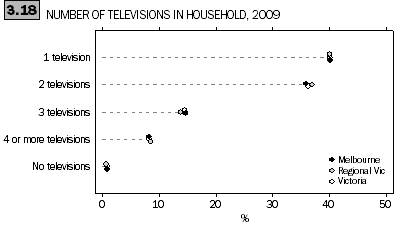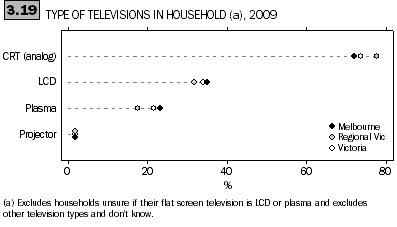TELEVISIONS
In 2008, the federal government introduced a voluntary television labelling scheme to enable consumers to identify the most energy efficient televisions. The labelling scheme became mandatory in mid 2009 with the introduction of the Minimum Energy Performance Standards (MEPS) under state based legislation (DCCEE 2010).
Televisions on standby draw energy even when not in use. Across Australia, almost one-fifth of households with televisions had three or more switched on and ready to use (ABS 2008). 55% of Victorians in 2009 had not turned the television off at the power point when not watching it (SV 2009).

Nearly all Victorian households had a television (2,075,200) and a small number (16,600) had none. Melbourne had 1,491,700 households with at least one television and regional Victoria had 586,900 households with at least one television (both at 99%).
Most Victorian households had one or two televisions (77%). It was less common for households to have three or more televisions, where 15% had three televisions and 8.3% had four or more. Melbourne and regional Victoria had similar rates of numbers of televisions in the household.
Households with children had a higher rate of three or four or more televisions (20% and 14% respectively) compared to households without children (12% and 6.1% respectively). Households with three to five people were more likely to have four or more televisions (16%).
Households with higher incomes also had a higher rate of four or more televisions. 2.7% of households with the lowest incomes had four or more televisions, but 16% of households with the highest incomes had four or more.

Most Victorian households had a cathode ray tube (CRT) television (74%). The majority, 1,112,000, had flat screen televisions (either LCD or plasma) (54%) and a small number had projectors (36,900 or 1.8%).
Victorian households were more likely to have CRT televisions if their household income was low. For households with a household income less than $25,000 a year, 81% had an CRT television, whereas 67% of households with an income of $110,00 or more per year had an CRT television. The inverse was true in flat screen televisions where households with the highest income had a higher rate of flat screen televisions (74%) than households with the lowest income (32%).
Victorian lone person households or households in rented dwellings were less likely to have a flat screen television. For persons living alone, 38% had a flat screen television while for households in rented dwellings, 43% had a flat screen television which was lower than the Victorian rate of 54%.
Plasma flat screen televisions were more prevalent in households with children and households with more residents. Almost one third of Victorian households with children had a plasma television, compared to 18% of households without children. Larger households (three to five persons) had 30% with a plasma television, higher than for a two person household at 18%.
References
ABS (Australian Bureau of Statistics) 2008, Environmental Issues: Energy Use and Conservation, Cat. no. 4602.0.55.001, ABS, Canberra.
DCCEE (Department of Climate Change and Energy Efficiency, ‘Minimum Energy Performance Standards (MEPS) ‘Regulations in Australia – Overview’, Energy Rating, < http://www.energyrating.gov.au/meps1.html> last viewed on 16 June 2010.
SV (Sustainability Victoria) 2009, 2009 Green Light Report, The State of Victoria, Melbourne.
 Print Page
Print Page
 Print All
Print All
 Print Page
Print Page
 Print All
Print All